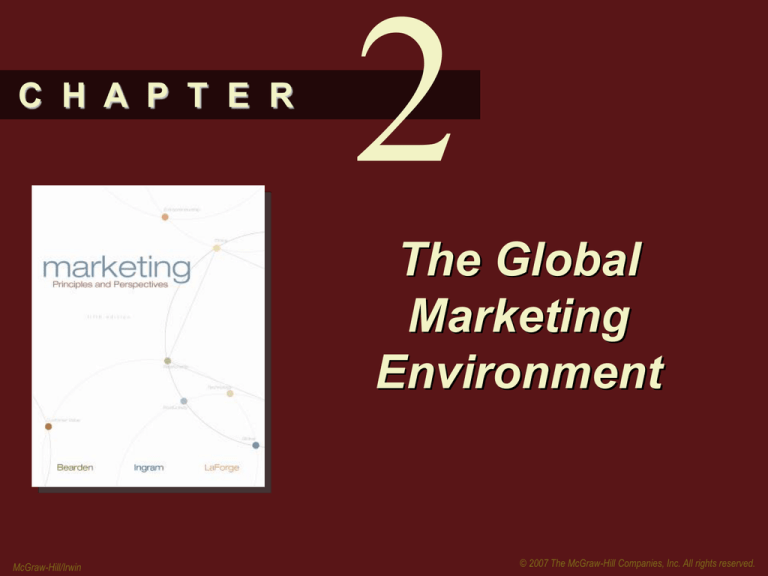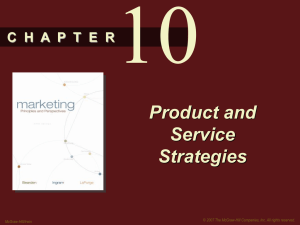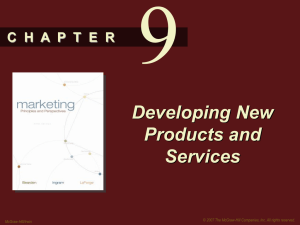
C H A P T E R
2
The Global
Marketing
Environment
McGraw-Hill/Irwin
© 2007 The McGraw-Hill Companies, Inc. All rights reserved.
Learning Objectives
After studying this chapter, you should be able to:
Understand the nature of the marketing environment and
why it is important to marketers.
Describe the major components of the social environment
and how trends in the social environment affect
marketing.
Understand how the economic environment affects
marketing.
See how the political/legal environment offers
opportunities and threats to marketers.
Appreciate the importance of the technological
environment to marketers.
Understand differences in the competitive environment.
Know how changes in the institutional environment affect
marketers.
Bearden Marketing 5th Ed
2-2
© 2007 The McGraw-Hill Companies, Inc. All rights reserved.
Dell
Michael Dell founded Dell Computer Corporation with
$1,000 when he was a college student at the University
of Texas at Austin in 1984. Today Dell is the world’s
leading direct computer systems company with annual
revenues in excess of $40 billion and over 34,000
employees.
Bearden Marketing 5th Ed
2-3
© 2007 The McGraw-Hill Companies, Inc. All rights reserved.
The Marketing Environment
The marketing environment consists of all factors
external to an organization that can affect the
organization’s marketing activities.
Exhibit 2-1
Bearden Marketing 5th Ed
2-4
© 2007 The McGraw-Hill Companies, Inc. All rights reserved.
Identifying Market Opportunities and Threats
Many firms use environmental scanning to identify important trends
and determine whether they represent present or future market
opportunities or threats.
Exhibit 2-2
Bearden Marketing 5th Ed
2-5
© 2007 The McGraw-Hill Companies, Inc. All rights reserved.
The Social Environment
The social environment includes all factors and trends
related to groups of people, including their number,
characteristics, behavior, and growth projections.
Number of
People
Growth
Projection
Social
Environment
Characteristics
Behavior
Bearden Marketing 5th Ed
2-6
© 2007 The McGraw-Hill Companies, Inc. All rights reserved.
The Demographic Environment
The demographic environment refers to the size,
distribution, and growth rate of groups of people with
different characteristics.
The demographic characteristics of interest to marketers
relate in some way to purchasing behavior, because
people from different countries, cultures, age groups, or
household arrangements often exhibit different
purchasing behaviors.
A global perspective requires that marketers be familiar
with important demographic trends around the world as
well as within the United States.
Bearden Marketing 5th Ed
2-7
© 2007 The McGraw-Hill Companies, Inc. All rights reserved.
Population Estimate —Year 2025
Exhibit 2-3
Bearden Marketing 5th Ed
2-8
© 2007 The McGraw-Hill Companies, Inc. All rights reserved.
Demographic Trends
World and country population statistics are
important, but most marketers target
subgroups. Trends in population subgroups
are typically the most useful to marketers, for
example, the growth of the urban population.
Bearden Marketing 5th Ed
2-9
© 2007 The McGraw-Hill Companies, Inc. All rights reserved.
Demographic Trends
Another interesting trend is the aging of the
population. The aging of the population is
especially evident in Italy, Japan, Britain, and
the United States.
Bearden Marketing 5th Ed
2-10
© 2007 The McGraw-Hill Companies, Inc. All rights reserved.
The Cultural Environment
The cultural environment refers to factors and
trends related to how people live and behave.
Values
Subgroup
Activities
Cultural
Factors
Beliefs
Bearden Marketing 5th Ed
Ideas
Attitudes
2-11
© 2007 The McGraw-Hill Companies, Inc. All rights reserved.
Cultural Diversity
Cultural differences are important in both international and
domestic markets.
Much of the population and buying power growth in the
United States is and will be from multicultural groups.
Exhibit 2-6
Bearden Marketing 5th Ed
2-12
© 2007 The McGraw-Hill Companies, Inc. All rights reserved.
Changing Roles
As more women enter the
workforce and household
compositions change,
typical household roles are
altered.
Tremendous market
opportunities exist for firms
that can develop effective
strategies for appealing to
these changing roles.
Bearden Marketing 5th Ed
2-13
© 2007 The McGraw-Hill Companies, Inc. All rights reserved.
Emphasis on Health & Fitness
The pursuit of a more healthful lifestyle includes:
eating more nutritious foods
exercising regularly
participating in various sports activities
focusing on wellness.
This translates into potential market
opportunities for firms that provide products and
services geared toward improving health and
fitness.
Bearden Marketing 5th Ed
2-14
© 2007 The McGraw-Hill Companies, Inc. All rights reserved.
The Desire for Convenience
Increased desire for convenience created by:
Changes in household composition
Increases in the number of working women
General shortage of time
Bearden Marketing 5th Ed
2-15
© 2007 The McGraw-Hill Companies, Inc. All rights reserved.
Consumerism
Consumerism is the movement
to establish and protect the
rights of buyers.
One increasingly important
consumer issue is
environmentalism.
Successful marketers can
respond by developing
environmentally safe products
and communicating their
environmental contributions.
Bearden Marketing 5th Ed
2-16
© 2007 The McGraw-Hill Companies, Inc. All rights reserved.
The Economic Environment
The economic environment includes factors
and trends related to income levels and the
production of goods and services.
Economic trends in different parts of the world
can affect marketing activities in other parts of
the world.
The gross domestic product (GDP) represents
the total size of a country’s economy measured
in the amount of goods and services produced.
Bearden Marketing 5th Ed
2-17
© 2007 The McGraw-Hill Companies, Inc. All rights reserved.
The Political/Legal Environment
The political/legal environment encompasses factors
and trends related to governmental activities and specific
laws and regulations that affect marketing practice.
Global
Trends
Political
Legal
Environment
Regulation
Bearden Marketing 5th Ed
Legislation
2-18
© 2007 The McGraw-Hill Companies, Inc. All rights reserved.
Global Political Trends
In today’s world economy, international political
events greatly affect marketing activities. For
example the impact of the war on terrorism on
the travel and security industries.
A second important political trend is movement
toward free trade and away from protectionism.
Studies show that countries with the freest trade
have the highest GDP growth.
Bearden Marketing 5th Ed
2-19
© 2007 The McGraw-Hill Companies, Inc. All rights reserved.
Legislation
Bearden Marketing 5th Ed
2-20
© 2007 The McGraw-Hill Companies, Inc. All rights reserved.
Regulations and Regulatory Agencies
Most legislation in the United States is
enforced through regulations developed by a
variety of agencies, and marketers must often
work with regulatory authorities at the federal,
state, and local levels.
Bearden Marketing 5th Ed
2-21
© 2007 The McGraw-Hill Companies, Inc. All rights reserved.
The Technological Environment
The technological environment includes
factors and trends related to innovations that
affect the development of new products or the
marketing process.
These technological trends can provide
opportunities for new product development,
affect how marketing activities are performed,
or both.
Bearden Marketing 5th Ed
2-22
© 2007 The McGraw-Hill Companies, Inc. All rights reserved.
The Competitive Environment
The competitive environment consists of all
the organizations that attempt to serve similar
customers.
Brand
Competitors
The most direct competition, offering the
same types of products as competing firms.
For example, Nike is a brand competitor of
Reebok as both companies manufacture
shoes.
Product
Competitors
Offer different types of products to satisfy
the same general need. Domino’s Pizza,
McDonald’s, and Kentucky Fried Chicken
are product competitors.
Bearden Marketing 5th Ed
2-23
© 2007 The McGraw-Hill Companies, Inc. All rights reserved.
The Institutional Environment
The institutional environment consists of all
the organizations involved in marketing
products and services.
Market
Research Firms
Retailers
Advertising
Suppliers
Wholesalers
Customers
Bearden Marketing 5th Ed
2-24
© 2007 The McGraw-Hill Companies, Inc. All rights reserved.
The Future
The only certainty about the future is that
it will be uncertain, and change will occur
at an increasing rate.
It will also be more complex.
Businesses and consumers now must
operate in an era of terrorism and lack of
trust.
Bearden Marketing 5th Ed
2-25
© 2007 The McGraw-Hill Companies, Inc. All rights reserved.
Summary
After studying this chapter, you should be able to:
Understand the nature of the marketing environment and
why it is important to marketers.
Describe the major components of the social environment
and how trends in the social environment affect
marketing.
Understand how the economic environment affects
marketing.
See how the political/legal environment offers
opportunities and threats to marketers.
Appreciate the importance of the technological
environment to marketers.
Understand differences in the competitive environment.
Know how changes in the institutional environment affect
marketers.
Bearden Marketing 5th Ed
2-26
© 2007 The McGraw-Hill Companies, Inc. All rights reserved.







